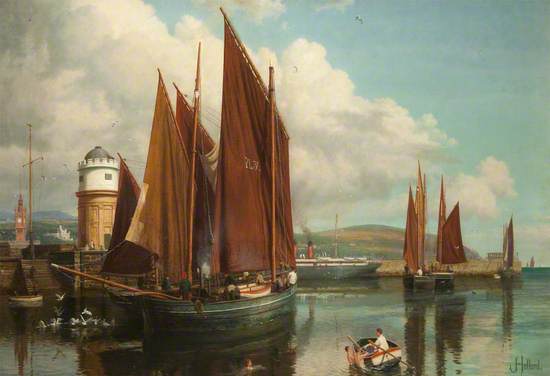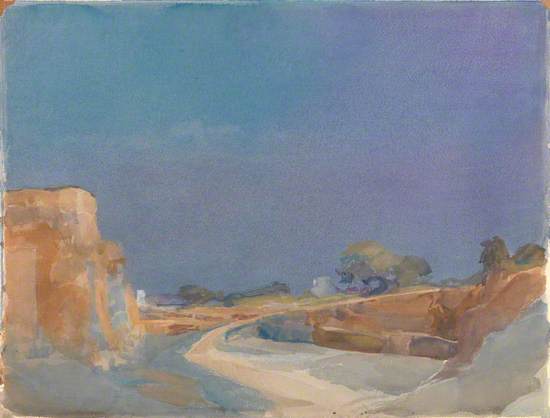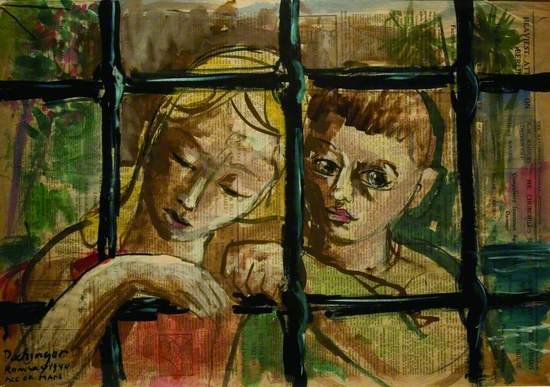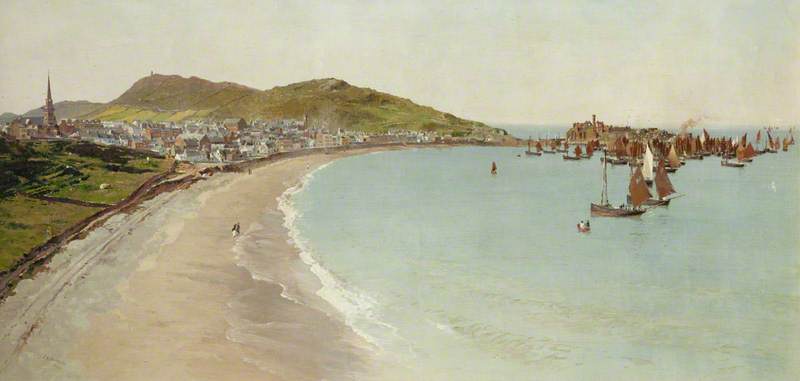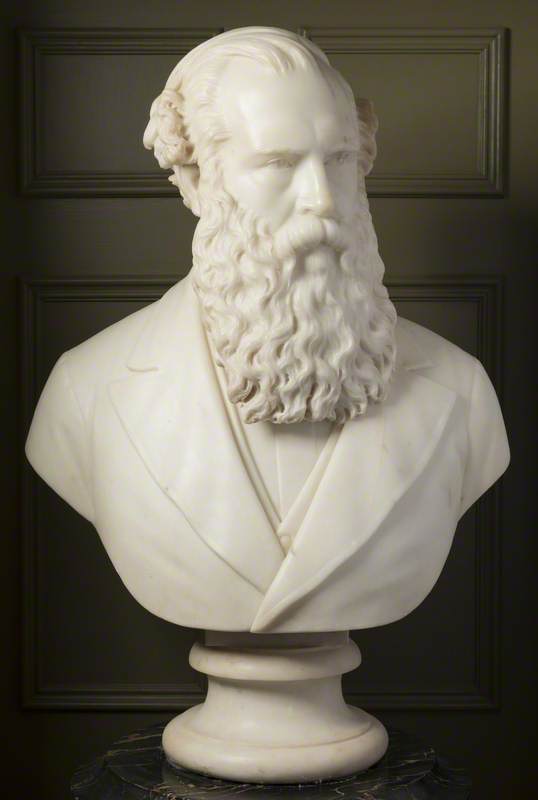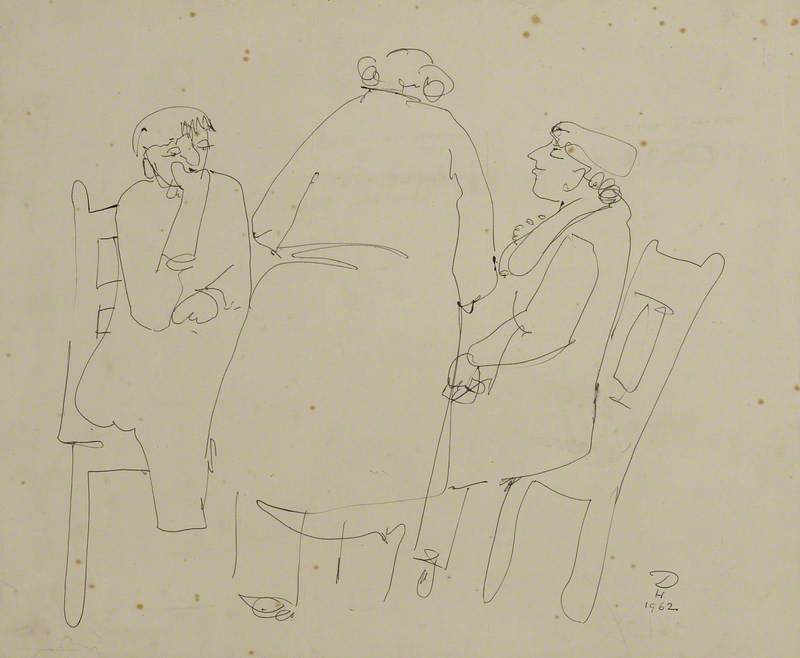Manx National Heritage is responsible for protecting and promoting the Isle of Man’s natural and cultural heritage. We are a registered charity and look after some of the Island’s most special places, spaces, archives and museum collections, making these available to people across the world. Since the Manx Museum opened in 1922 only artwork by Manx artists, artists working on the Isle of Man or artworks inspired by the Island have been collected.
Art Unlocked is an online talk series by Art UK in collaboration with Bloomberg Philanthropies. This Curation is based on a talk by Katie King, Curator of Art & Social History at Manx National Heritage, on 26th January 2022. You can find a recording at: https://youtu.be/ZBi9zK9dYvU
A calm and tranquil scene in Douglas Harbour during the height of the Isle of Man’s tourist heyday. A Steam Packet ship waits to gather visitors at the Victoria pier, whilst holiday makers enjoy swimming and rowing in the bay. Landmark buildings such as the Victoria Terminal and Falcon Cliff Hotel can be seen in the background. To the foreground an idealised image of the Douglas Herring Fleet is depicted nestled alongside the Red Pier. John Holland moved to the Isle of Man in 1883 and established himself as a prolific artist, specialising in large detailed oil paintings and charcoal drawings of Manx scenes for the dining rooms and parlours of Douglas hotels and boarding houses.
John Holland (1857–1920)
Oil on canvas
H 72 x W 123 cm
Manx National Heritage
A typical summer evening of enticing entertainments for the Victorian holiday-maker in Douglas. With the glamourous colour and lights of the Grand Theatre illuminating the busy crowd in the foreground. John Miller Nicholson is known as the Island’s greatest painter. He spent most of his life living and working in Douglas obsessively recording the world and people around him with detailed sketches. Following a trip to Venice in 1882, on the advice of John Ruskin, Nicholson’s work became more impressionistic. A style he would develop through the rest of his career. His self-effacing and non-commercial attitude meant that his work is little known outside the Island today.
John Miller Nicholson (1840–1913)
Oil on canvas
H 45 x W 80 cm
Manx National Heritage
Archibald Knox is internationally celebrated as a leading designer in the Art Nouveau movement. His intensely personal work as a watercolour artist is less well-known. He painted for himself and his paintings were rarely signed or sold. His watercolours capture the ever-changing nature of the Manx landscape, striving to capture the essence of form, colour and spirit of the Island. This atmospheric piece from the large collection of Knox watercolours held at the Manx Museum shows a track leading out of a quarry, with whitewashed cottages in the distance surrounded by trees. The dramatic sky a fleeting moment captured by Knox forever.
Archibald Knox (1864–1933)
Watercolour on paper
H 44.5 x W 58 cm
Manx National Heritage
A marble bust of James Brown, reformer, journalist and founder of the Isle of Man Times, by Joseph William Swynnerton of Douglas. James Brown (1815-1881) was the son of a freed slave. In 1846 he came to the Isle of Man from Liverpool. He founded the Isle of Man Times in 1861 and waged a campaign against the Island's Government to introduce reforms such as a popularly elected House of Keys. Joseph William Swynnerton was a highly accomplished and much sought after Manx sculptor, who went on to study and live in Italy. On trips back to the Island he carved busts of many local dignitaries, a number of which are in Manx National Heritage’s collections.
Joseph William Swynnerton (1848–1910)
Stone & marble
H 195.5 x W 63 x D 38 cm
Manx National Heritage
A powerful image of two children, with a wire fence and palm trees. The boy stares accusingly at us, whilst the girl looks down with soulful look. Which side of the wire fence the children are on is left in doubt. It was painted by Austrian Jewish artist Hugo Dachinger whilst interned at Mooragh Internment Camp in Ramsey on the Isle of Man. Although only interned for seven months, Dachinger produced a vast quantity of artwork, often painted on newspaper. Whilst in Mooragh Camp and following his release in January 1941, Dachinger staged exhibitions of his work entitled ‘Art Behind Barbed Wire’. Manx National Heritage holds an internationally significance collection of internment art.
Hugo Dachinger (1908–1995)
Watercolour on newspaper
H 44.5 x W 62 cm
Manx National Heritage
Manx born Bryan Kneale is best known for his sculptures, but in the 1950s he was working as a portrait painter. The piece was collected by Manx National Heritage in 1968, and demonstrates an early effort to ensure contemporary artists were also represented in the national collections. MNH have a number of his portraits and sculptures in the collections. Recently Bryan Kneale recalls seeing the painting in the Manx Museum Art Gallery: 'I was quite surprised to see that painting of UGO after all this time…I remember painting it after I returned from Italy, and it was likely to have been shown in my first exhibition at the Redfern Gallery in 1954…UGO is a dwarf, and he is fiddling with a cigarette packet.’
